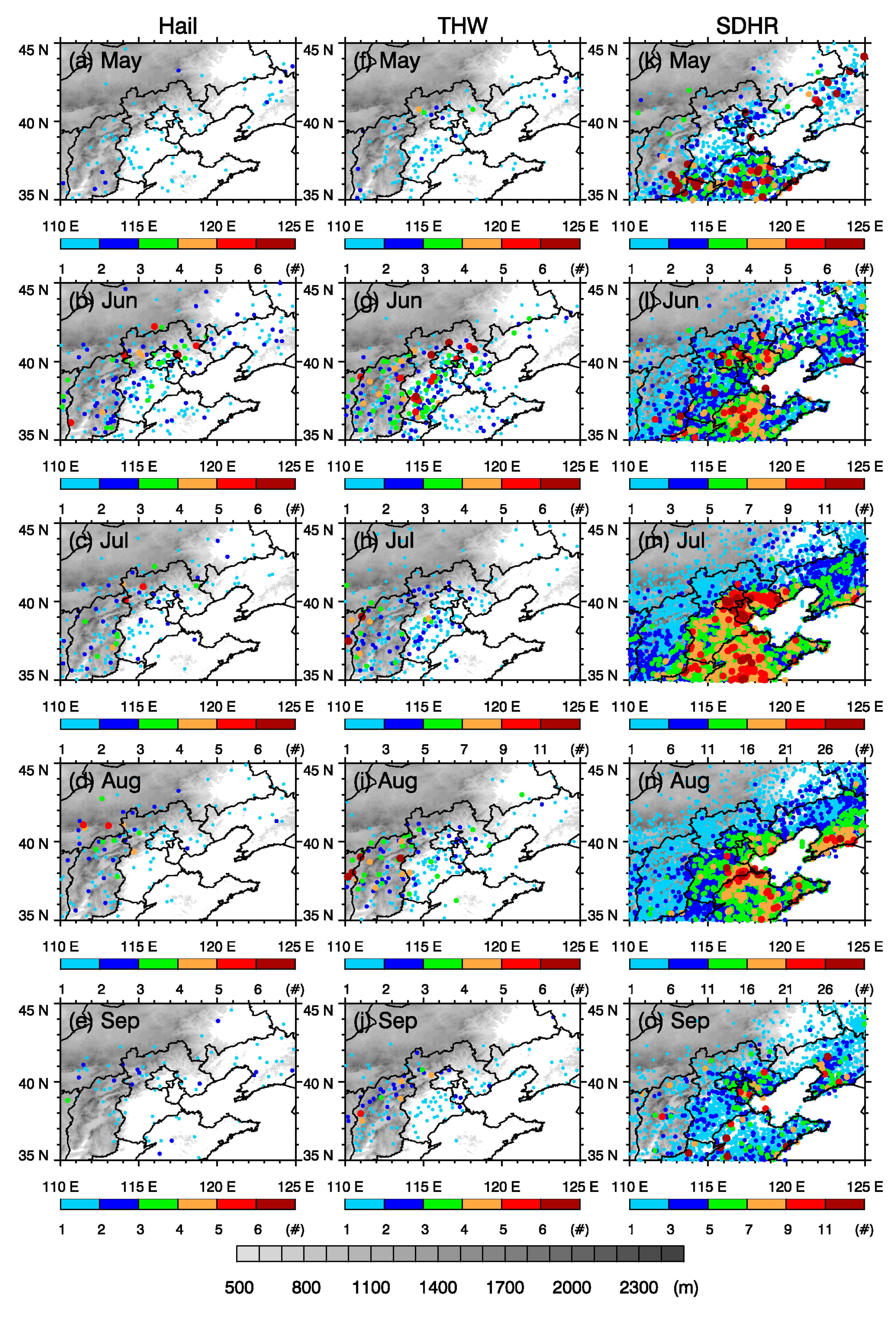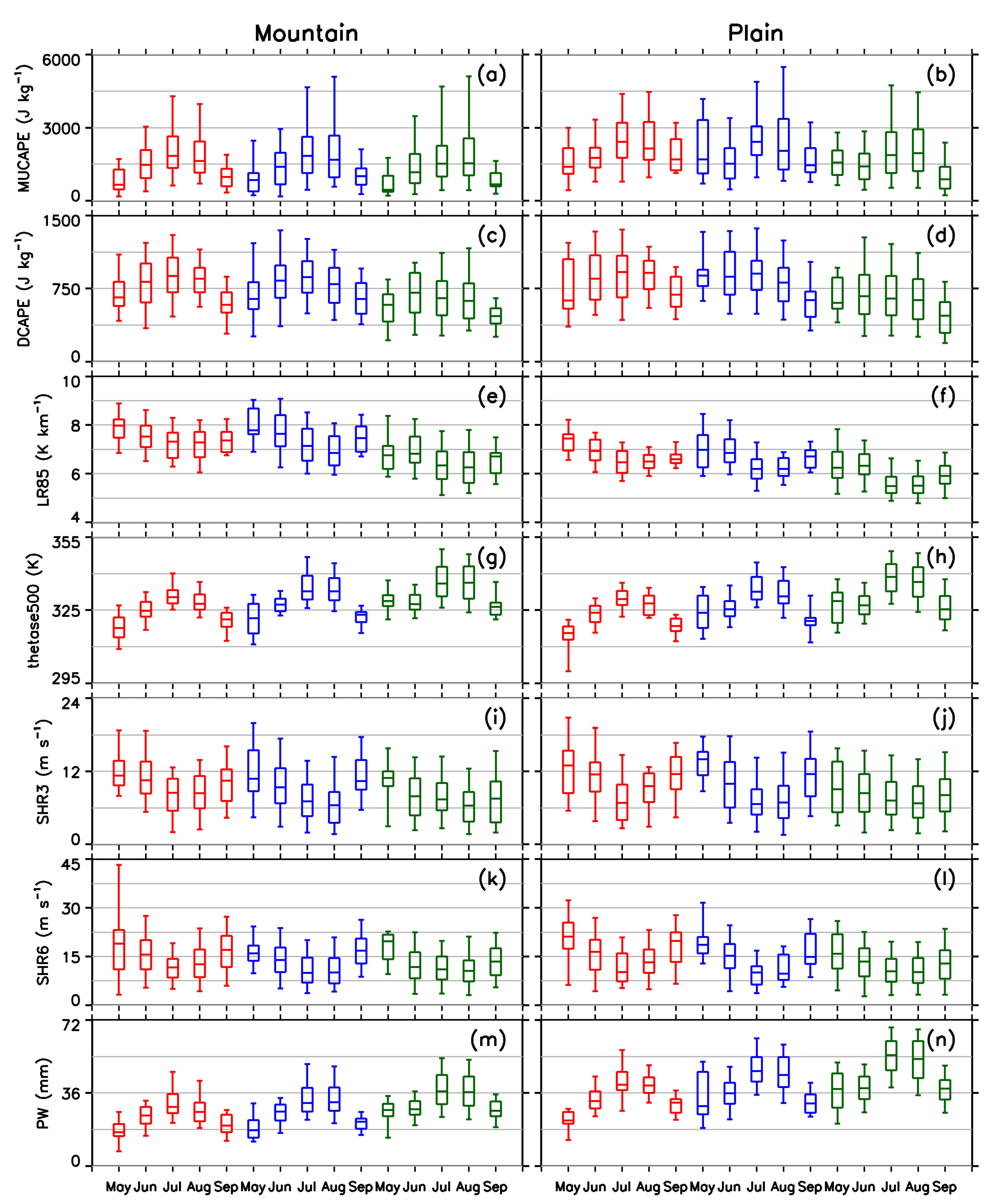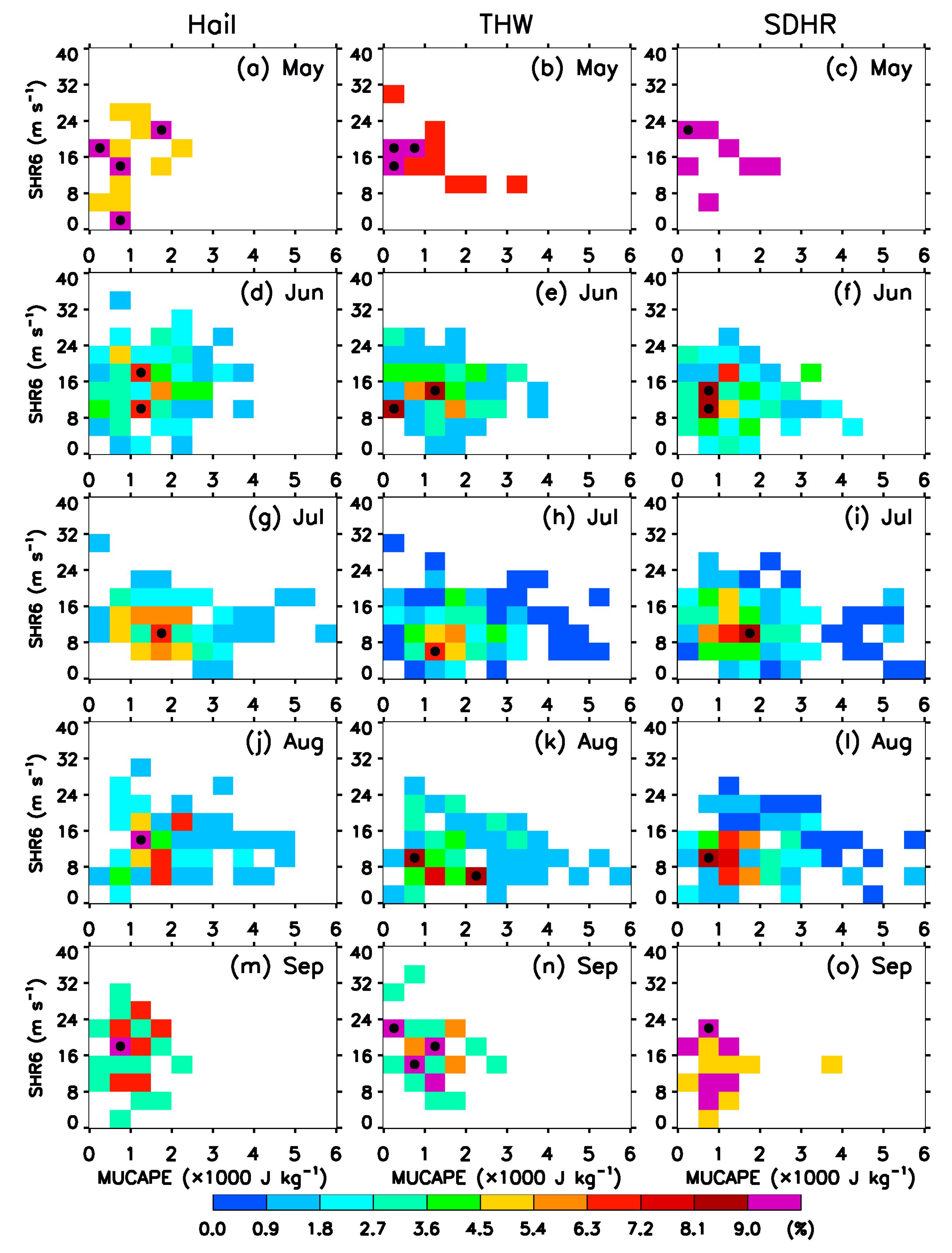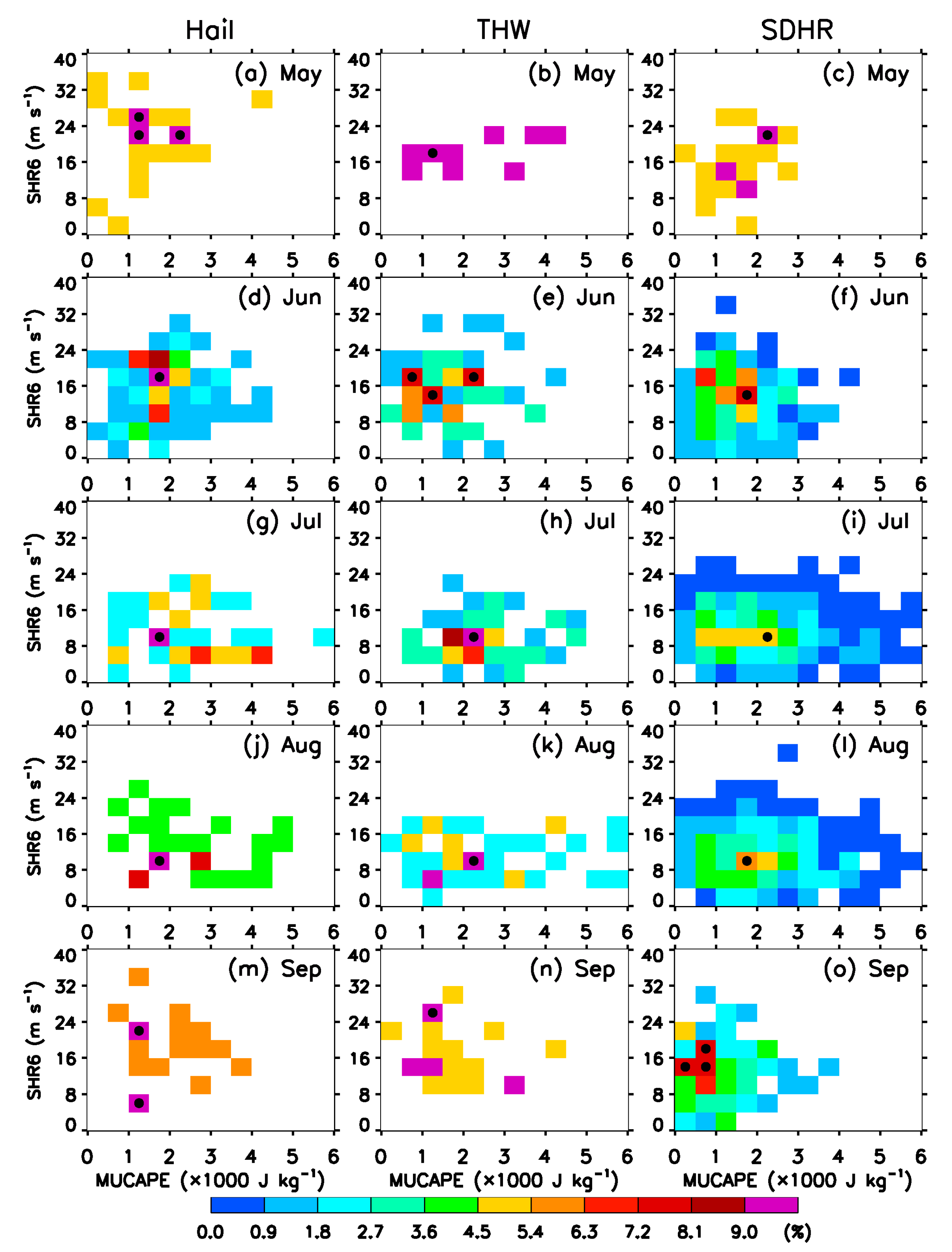Statistical Characteristics and Environmental Conditions of the Warm-Season Severe Convective Events over North China
Abstract
1. Introduction
2. Data and Methodology
2.1. The SWRs Dataset
2.2. Construction of Proximity Soundings
2.3. Parameter Computation
3. Results
3.1. Spatial and Temporal Distributions of the Severe Convective Events
3.2. Environmental Parameters Associated with the Severe Convective Events
3.2.1. Severe Convective Events as Functions of Altitude and Severity
3.2.2. Severe Convective Events as Functions of Altitude and Month
4. Conclusions
Supplementary Materials
Author Contributions
Funding
Institutional Review Board Statement
Informed Consent Statement
Data Availability Statement
Acknowledgments
Conflicts of Interest
References
- Zheng, Y.G.; Zhou, K.H.; Sheng, J.; Lin, Y.J.; Tian, F.Y.; Tang, W.Y.; Lan, Y.; Zhu, W.J. Advances in techniques of monitoring, forecasting and warning of severe convective weather. J. Appl. Meteorol. Sci. 2015, 26, 641–657. (In Chinese) [Google Scholar]
- Li, M.X.; Zhang, D.-L.; Sun, J.S. A Statistical Analysis of Hail Events and Their Environmental Conditions in China during 2008–15. J. Appl. Meteorol. Climatol. 2018, 57, 2817–2833. [Google Scholar] [CrossRef]
- Chen, J.; Zheng, Y.G.; Zhang, X.L.; Zhu, P.J. Distribution and diurnal variation of warm-season short-duration heavy rainfall in relation to the MCSs in China. Acta Meteorol. Sin. 2013, 27, 868–888. [Google Scholar] [CrossRef]
- Meng, Z.Y.; Yan, D.; Zhang, Y.J. General features of squall lines in east China. Mon. Weather Rev. 2013, 141, 1629–1647. [Google Scholar] [CrossRef]
- Yang, X.L.; Sun, J.H.; Zheng, Y.G. A 5-yr climatology of severe convective wind events over China. Weather Forecast. 2017, 32, 1289–1299. [Google Scholar] [CrossRef]
- Sun, J.S.; Yang, B. Meso-β scale torrential rain affected by topography and the urban circulations. Chin. J. Atmos. Sci. 2008, 32, 1352–1364. (In Chinese) [Google Scholar]
- Chen, M.X.; Wang, Y.C.; Gao, F.; Xiao, X. Diurnal variations in convective storm activity over contiguous North China during the warm season based on radar mosaic climatology. J. Geophys. Res. 2012, 117, 20115. [Google Scholar] [CrossRef]
- Chen, M.X.; Xiao, X.; Gao, F.; Lei, L.; Wang, Y.C.; Sun, J.Z. A case study and batch verification on high resolution numerical simulations of severe convective events using an analysis based on rapid-refresh 4-D variational radar data assimilation. Acta Meteorol. Sin. 2016, 74, 421–441. (In Chinese) [Google Scholar]
- Li, H.Q.; Cui, X.P.; Zhang, D.-L. On the initiation of an isolated heavy-rain-producing storm near the central urban area of the Beijing metropolitan region. Mon. Weather Rev. 2017, 145, 181–197. [Google Scholar] [CrossRef]
- Doswell, C.A., III. The distinction between large-scale and mesoscale contribution to severe convection: A case study example. Weather Forecast. 1994, 9, 625–629. [Google Scholar] [CrossRef]
- Doswell, C.A., III; Brooks, H.E.; Maddox, R.A. Flash-flood forecasting: An ingredients-based methodology. Weather Forecast. 1996, 11, 560–581. [Google Scholar] [CrossRef]
- Wetzel, S.W.; Martin, J.E. An operational ingredients-based methodology for forecasting midlatitude winter season precipitation. Weather Forecast. 2000, 16, 156–167. [Google Scholar] [CrossRef]
- Zhang, X.L.; Tao, S.Y.; Sun, J.H. Ingredients-based heavy rainfall forecasting. Chin. J. Atmos. Sci. 2010, 34, 754–766. (In Chinese) [Google Scholar]
- Brooks, H.E.; Doswell, C.A., III; Cooper, J. On the environments of tornadic and nontornadic mesocyclones. Weather Forecast. 1994, 9, 606–618. [Google Scholar] [CrossRef]
- Rasmussen, E.N.; Blanchard, D.O. A baseline climatology of sounding-derived supercell and tornado forecast parameters. Weather Forecast. 1998, 13, 1148–1164. [Google Scholar] [CrossRef]
- Brooks, H.E.; Craven, J.P. A database proximity soundings for significant severe thunderstorms, 1957–1993. In Proceedings of the 21st Conference on Severe Local Storms, San Antonio, TX, USA, 11–16 October 2001. [Google Scholar]
- Thompson, R.L.; Edwards, R.; Hart, J.A.; Elmore, K.L.; Markowski, P. Close proximity soundings within supercell environments obtained from the Rapid Update Cycle. Weather Forecast. 2003, 18, 1243–1261. [Google Scholar] [CrossRef]
- Thompson, R.L.; Mead, C.M.; Edwards, R. Effective storm-relative helicity and bulk shear in supercell thunderstorm environments. Weather Forecast. 2007, 22, 102–115. [Google Scholar] [CrossRef]
- Groenemeijer, P.H.; van Delden, A. Sounding-derived parameters associated with large hail and tornadoes in the Netherlands. Atmos. Res. 2007, 83, 473–487. [Google Scholar] [CrossRef]
- Taszarek, M.; Kolendowicz, L. Sounding-derived parameters associated with tornado occurrence in Poland and universal tornadic index. Atmos. Res. 2013, 134, 186–197. [Google Scholar] [CrossRef]
- Hurlbut, M.M.; Cohen, A.E. Environments of Northeast U.S. severe thunderstorm events from 1999 to 2009. Weather Forecast. 2014, 29, 3–22. [Google Scholar] [CrossRef][Green Version]
- Púčik, T.; Groenemeijer, P.; Rýva, D.; Kolář, M. Proximity soundings of severe and nonsevere thunderstorms in central Europe. Mon. Weather Rev. 2015, 143, 4805–4821. [Google Scholar] [CrossRef]
- Tuovinen, J.; Rauhala, J.; Schultz, D.M. Significant-hail-producing storms in Finland: Convective-storm environment and mode. Weather Forecast. 2015, 30, 1064–1076. [Google Scholar] [CrossRef]
- Kahraman, A.; Kadioglu, M.; Markowski, P.M. Severe convective storm environments in Turkey. Mon. Weather Rev. 2017, 145, 4711–4725. [Google Scholar] [CrossRef]
- Liao, X.N. Analysis on environmental condition for wind gust in Beijing area. Clim. Environ. Res. 2009, 14, 54–62. (In Chinese) [Google Scholar]
- Lei, L.; Sun, J.S.; Wei, D. Distinguishing the category of the summer convective weather by sounding data in Beijing. Meteorol. Mon. 2011, 37, 136–141. (In Chinese) [Google Scholar]
- Fan, L.M.; Yu, X.D. Characteristic analyses on environmental parameters in short-term severe convective weather in China. Plateau Meteorol. 2013, 32, 156–165. (In Chinese) [Google Scholar]
- Chen, Y.Z.; Yu, X.D.; Chen, X.L. Characteristics of short-time severe rainfall events based on weather flow and key environmental parameters in Pearl River Delta. Meteorol. Mon. 2016, 42, 144–155. (In Chinese) [Google Scholar]
- Fang, C.; Wang, X.G.; Sheng, J.; Cao, Y.C. Temporal and spatial distribution of North China thunder-gust winds and the statistical analysis of physical characteristics. Plateau Meteorol. 2017, 36, 1368–1385. (In Chinese) [Google Scholar]
- Yang, X.L.; Sun, J.H.; Lu, R.; Zhang, X. Environmental characteristics of severe convective wind over South China. Meteorol. Mon. 2017, 43, 769–780. (In Chinese) [Google Scholar]
- Cao, Y.C.; Tian, F.Y.; Zheng, Y.G.; Sheng, J. Statistical characteristics of environmental parameters for hail over the two-step terrains of China. Plateau Meteorol. 2018, 37, 185–196. (In Chinese) [Google Scholar]
- Gao, X.M.; Yu, X.D.; Wang, L.J.; Wang, W.B.; Wang, S.J.; Wang, X.H.; Han, X. Characteristics of environmental parameters for classified severe convective weather in central area of Shandong province. Acta Meteorol. Sin. 2018, 76, 196–212. (In Chinese) [Google Scholar]
- Tian, F.Y.; Zheng, Y.G.; Zhang, T.; Zhang, X.L.; Mao, D.Y.; Sun, J.H.; Zhao, S.X. Statistical characteristics of environmental parameters for warm-season short-duration heavy rainfall over central and eastern China. J. Meteorol. Res. 2015, 29, 370–384. [Google Scholar] [CrossRef]
- Qin, L.; Li, Y.D.; Gao, S.T. The synoptic and climatic characteristics studies of thunderstorm winds in Beijing. Clim. Environ. Res. 2006, 11, 754–762. (In Chinese) [Google Scholar]
- Yan, S.Y.; Li, Y.Y.; Qi, L.L.; An, J.; Liu, J. Analysis and application of thermo-dynamical and dynamical indexes associated with thunderstorm gale in North China. Torrential Rain Disaster 2013, 32, 17–23. (In Chinese) [Google Scholar]
- Chai, D.H.; Yang, X.L.; Wu, Z.Y.; Yan, X.J.; Pei, Y.J.; Li, Z.T.; Zhang, Y.J. The statistical analysis of thunderstorm gales over Beijing-Tianjin-Hebei region. Torrential Rain Disaster 2017, 36, 193–199. (In Chinese) [Google Scholar]
- Yang, X.L.; Sun, J.H. Organizational modes of severe wind-producing convective systems over North China. Adv. Atmos. Sci. 2018, 35, 540–549. [Google Scholar] [CrossRef]
- Yu, Z.Y.; He, L.F.; Fan, G.Z.; Li, Z.C.; Su, Y.L. The basic features of the severe convection at the background of cold vortex over North China. J. Trop. Meteorol. 2011, 27, 89–94. (In Chinese) [Google Scholar]
- Xiao, X.; Sun, J.Z.; Chen, M.X.; Xie, X.S.; Wang, Y.C.; Ying, Z.M. The characteristics of weakly forced mountain-to-plain precipitation systems based on radar observations and high-resolution reanalysis. J. Geophys. Res. Atmos. 2017, 122, 3193–3213. [Google Scholar] [CrossRef]
- Craven, J.P.; Brooks, H.E.; Hart, J.A. Baseline climatology of sounding derived parameters associated with deep, moist convection. In Proceedings of the 21st Conference on Severe Local Storms, San Antonio, TX, USA, 11–16 October 2001. [Google Scholar]
- Taszarek, M.; Brooks, H.E.; Czernecki, B. Sounding-derived parameters associated with convective hazards in Europe. Mon. Weather Rev. 2017, 145, 1511–1528. [Google Scholar] [CrossRef]
- Zheng, L.L.; Sun, J.H.; Zhang, X.L.; Liu, C.H. Organizational Modes of Mesoscale Convective Systems over Central East China. Weather Forecast. 2013, 28, 1081–1098. [Google Scholar] [CrossRef]
- Fan, W.J.; Yu, X.D. Characteristics of spatial-temporal distribution of tornadoes in China. Meteorol. Mon. 2015, 41, 793–805. (In Chinese) [Google Scholar]
- Copernicus Climate Change Service (C3S). ERA5: Fifth Generation of ECMWF Atmospheric Reanalyses of the Global Climate. Copernicus Climate Change Service Climate Data Store (CDS). 2017. Available online: https://cds.climate.copernicus.eu/cdsapp#!/home (accessed on 22 November 2019).
- Brooks, H.E.; Lee, J.W.; Craven, J.P. The spatial distribution of severe thunderstorm and tornado environments from global reanalysis data. Atmos. Res. 2003, 67–68, 73–94. [Google Scholar] [CrossRef]
- Brooks, H.E.; Anderson, A.R.; Riemann, K.; Ebbers, I.; Flachs, H. Climatological aspects of convective parameters from the NCAR/NCEP reanalysis. Atmos. Res. 2007, 83, 294–305. [Google Scholar] [CrossRef]
- Markowski, P.M.; Hannon, C.; Frame, J.; Lancaster, E.; Pietrycha, A.; Edwards, R.; Thompson, R.L. Characteristics of vertical wind profiles near supercells obtained from the Rapid Update Cycle. Weather Forecast. 2003, 18, 1262–1272. [Google Scholar] [CrossRef]
- Allen, J.T.; Karoly, D.J. A climatology of Australian severe thunderstorm environments 1979–2011: Inter-annual variability and ENSO influence. Int. J. Climatol. 2014, 34, 81–97. [Google Scholar] [CrossRef]
- Wang, X.M.; Yu, X.D.; Zhu, H. The applicability of NCEP reanalysis data to severe convection environment analysis. J. Appl. Meteorol. Sci. 2012, 23, 139–146. (In Chinese) [Google Scholar]
- Gensini, V.A.; Mote, T.L.; Brooks, H.E. Severe-thunderstorm reanalysis environments and collocated radiosonde observations. J. Appl. Meteorol. Climatol. 2014, 53, 742–751. [Google Scholar] [CrossRef]
- King, A.T.; Kennedy, A.D. North American supercell environments in atmospheric reanalysis and RUC-2. J. Appl. Meteorol. Climatol. 2019, 58, 71–92. [Google Scholar] [CrossRef]
- Johnson, R.H.; Bresch, J.F. Diagnosed characteristics of precipitation systems over Taiwan during the May June 1987 TAMEX. Mon. Weather Rev. 1991, 119, 2540–2557. [Google Scholar] [CrossRef]
- Pan, Y.J.; Zhao, K.; Pan, Y.N. Single-Doppler radar observation of a heavy-precipitation supercell on a severe squall line. Acta Meteorol. Sin. 2008, 66, 621–636. (In Chinese) [Google Scholar]
- Johnson, A.W.; Sugden, K.E. Evaluation of sounding-derived thermodynamic and wind-related parameters associated with large hail events. Electron. J. Severe Storms Meteorol. 2014, 9, 1–42. [Google Scholar]
- Reames, J.L. Diurnal Variations in Severe Weather Forecast Parameters of Rapid Update Cycle-2 Tornado Proximity Environments. Weather Forecast. 2017, 32, 743–761. [Google Scholar] [CrossRef]
- Johns, R.H.; Doswell, C.A., III. Severe local storms forecasting. Weather Forecast. 1992, 7, 588–612. [Google Scholar] [CrossRef]
- Weisman, M.L.; Klemp, J.B. The dependence of numerically simulated convective storms on vertical wind shear and buoyancy. Mon. Weather Rev. 1982, 110, 504–520. [Google Scholar] [CrossRef]
- Gilmore, M.S.; Wicker, L. The influence of midtropospheric dryness on supercell morphology and evolution. Mon. Weather Rev. 1998, 126, 943–958. [Google Scholar] [CrossRef]
- Browning, K.A.; Ludlam, F.H. Airflow in convective storms. Q. J. R. Meteorol. Soc. 2010, 88, 117–135. [Google Scholar] [CrossRef]
- Berthet, C.; Wesolek, E.; Dessens, J.; Sanches, J.L. Extreme hail day climatology in Southwestern France. Atmos. Res. 2013, 123, 139–150. [Google Scholar] [CrossRef]
- Doswell, C.A., III; Rasmussen, E.N. The effect of neglecting the virtual temperature correction on CAPE calculations. Weather Forecast. 1994, 9, 625–629. [Google Scholar] [CrossRef]
- University of Wyoming Atmospheric Soundings. Available online: http://weather.uwyo.edu/upperair/sounding.html (accessed on 10 December 2020).
- Wilks, D.S. Statistical Methods in the Atmospheric Sciences; Academic Press: Cambridge, MA, USA, 2011; p. 676. [Google Scholar]
- Li, X.F.; Zhang, Q.H.; Zou, T.; Lin, J.P.; Kong, H.; Ren, Z.H. Climatology of hail frequency and size in China, 1980–2015. J. Appl. Meteorol. Climatol. 2018, 57, 875–887. [Google Scholar] [CrossRef]
- He, H.Z.; Zhang, F.Q. Diurnal variations of warm-season precipitation over northern China. Mon. Weather Rev. 2010, 138, 1017–1025. [Google Scholar] [CrossRef]
- Wolyn, P.G.; McKee, T.B. The mountain–plains circulation east of a 2-km-high north–south barrier. Mon. Weather Rev. 1994, 122, 1490–1508. [Google Scholar] [CrossRef]
- Das, P. Influence of wind shear on the growth of hail. J. Atmos. Sci. 1962, 19, 407–414. [Google Scholar] [CrossRef]
- Dennis, E.J.; Kumjian, M.R. The impact of vertical wind shear on hail growth in simulated supercells. J. Atmos. Sci. 2017, 74, 641–663. [Google Scholar] [CrossRef]
- Tukey, J.W. Exploratory Data Analysis; Addison Wesley: Reading, MA, USA, 1977. [Google Scholar]
- Krzywinski, M.; Altman, N. Points of significance: Visualizing samples with box plots. Nat. Methods 2014, 11, 119–120. [Google Scholar] [CrossRef]












| Category | Definition | Category | Definition |
|---|---|---|---|
| Hail | Diameter ≥ 5 mm | Ordinary | 5 mm ≤ diameter < 10 mm |
| Significant | Diameter ≥ 10 mm | ||
| Thunderstorm high winds | Wind speeds ≥ 17.2 m s−1 | Ordinary | 17.2 m s−1 ≤ wind speeds < 24 m s−1 |
| Significant | Wind speeds ≥ 24 m s−1 | ||
| Short-duration heavy rainfall | Hourly rain ≥ 20mm h−1 | Ordinary | 20 mm h−1 ≤ hourly rain < 50 mm h−1 |
| Significant | Hourly rain ≥ 50 mm h−1 |
| Parameter Description | Abbreviation | Unit |
|---|---|---|
| Most unstable convective available potential energy | MUCAPE | J kg−1 |
| Downdraft convective available potential energy | DCAPE | J kg−1 |
| 850–500 hPa temperature lapse rate | LR85 | K km−1 |
| Pseudo-equivalent potential temperature at 500 hPa | thetase500 | K |
| 0–3 km above ground level bulk wind shear | SHR3 | m s−1 |
| 0–6 km above ground level bulk wind shear | SHR6 | m s−1 |
| Precipitable water from the surface to 300 hPa | PW | mm |
Publisher’s Note: MDPI stays neutral with regard to jurisdictional claims in published maps and institutional affiliations. |
© 2020 by the authors. Licensee MDPI, Basel, Switzerland. This article is an open access article distributed under the terms and conditions of the Creative Commons Attribution (CC BY) license (http://creativecommons.org/licenses/by/4.0/).
Share and Cite
Ma, R.; Feng, S.; Jin, S.; Sun, J.; Fu, S.; Sun, S.; Han, H. Statistical Characteristics and Environmental Conditions of the Warm-Season Severe Convective Events over North China. Atmosphere 2021, 12, 52. https://doi.org/10.3390/atmos12010052
Ma R, Feng S, Jin S, Sun J, Fu S, Sun S, Han H. Statistical Characteristics and Environmental Conditions of the Warm-Season Severe Convective Events over North China. Atmosphere. 2021; 12(1):52. https://doi.org/10.3390/atmos12010052
Chicago/Turabian StyleMa, Ruoyun, Shuanglei Feng, Shuanglong Jin, Jianhua Sun, Shenming Fu, Shijun Sun, and Hong Han. 2021. "Statistical Characteristics and Environmental Conditions of the Warm-Season Severe Convective Events over North China" Atmosphere 12, no. 1: 52. https://doi.org/10.3390/atmos12010052
APA StyleMa, R., Feng, S., Jin, S., Sun, J., Fu, S., Sun, S., & Han, H. (2021). Statistical Characteristics and Environmental Conditions of the Warm-Season Severe Convective Events over North China. Atmosphere, 12(1), 52. https://doi.org/10.3390/atmos12010052






